In 1631, the Burgh of Peebles made it illegal to let your chicken eat your neighbours thatched roof. In 1656, the Burgh ordained that all chickens must wear wooden clogs to prevent them flying up onto rooves.

In 1631, the Burgh of Peebles made it illegal to let your chicken eat your neighbours thatched roof. In 1656, the Burgh ordained that all chickens must wear wooden clogs to prevent them flying up onto rooves.

In March 1875, after a workplace disagreement, Dundee millworkers Elizabeth Melville and Gordonia Skinner met during their lunch break for a square-go in front of a large crowd. Elizabeth won by KO after 3 rounds then the two went back to work.

In 1840s Fife, a deserted spouse could have their marriage annulled if they set a place at the dinner table and shouted out the door for the absent spouse to come eat. After a year plus one day, they were free to marry again.

Every evening a fresh table setting had to be put out when the jilted spouse was ready to eat, and every time they’d have to call out that dinner was ready. Think it was to demonstrate good faith that you *wanted* your spouse to come home.
Built around 1750, the Old Manse of Kilbucho sits in a small glen between Broughton and Coulter in the Borders. In 1902, it was the scene of an unsolved mystery that left its occupants too terrified to spend another night in their home.
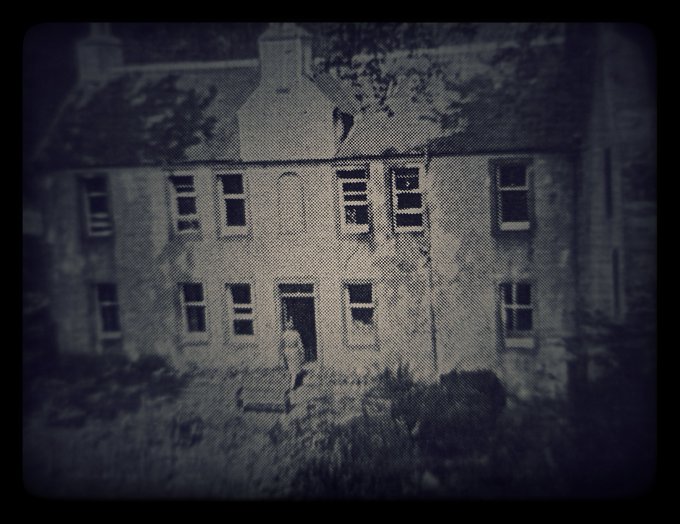
A private house for over a century, in February 1902 it was owned by Misses Elizabeth (50) and Isabella (46) Hope, who lived there themselves since the death of their father 9 months previously. The Old Manse sits tucked into a hollow next to the ruins of Kilbucho Kirk.

Apart from a few sheepfarms, the Old Manse has no real neighbours– you’d have to walk over an hour down the track in either direction to reach a village.

The two sisters had spent the evening of the 6th of February by the fire in their bedroom and decided to turn in at around 11pm. Their habit in winter was to open the shutters before bed to make the most of the morning daylight.
On a moonless night like that one was, the two sisters’ window, illuminated by the fireplace, would have visible to any passers-by (of which there shouldn’t be *any* as they lived in the middle of nowhere!)
A little after midnight the sisters were awoken by their window panes being smashed. By their candlelight, they saw a large masked figure with a beard hacking at their window frame with an axe.
After all the panes were broken, a revolver was then pointed through the window and two shots rang out. Both bullets hit the sisters’ headboard. Scrambling out of the room, the sisters ran down the hall to kitchen.
As soon as they got there though the masked figure started breaking another window and again opened fire– the rounds thudding into an open pantry door. Barefoot and pyjamaed, Elizabeth and Isabella flung open the kitchen door and ran off into the night.
They made for the farmhouse at Mitchellhill, 400 yards down the track, and were admitted by a bemused Tom and Jemima Todd. After hearing their story, Tom woke the shepherd and the two men made for the old manse armed with sticks and lanterns.
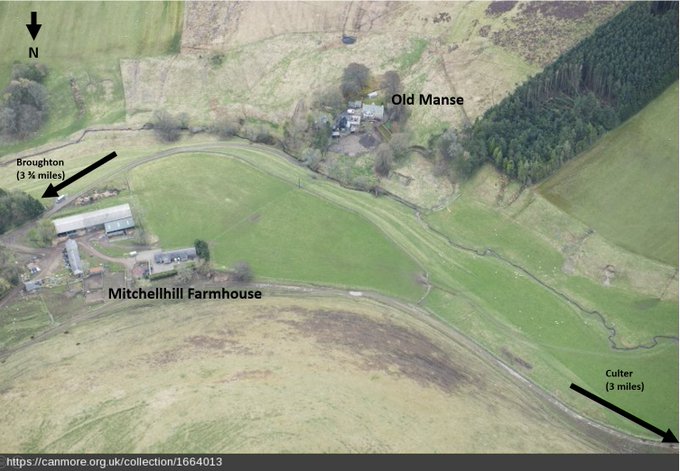
They found the house as the Hope sisters had left it–kitchen door open wide, glass and splintered wood on the floor. While Tom looked around the outbuildings, the shepherd ran back to the farmhouse to sound the alarm.
The shepherd returned with a posse of farmers who tried their best to track the mystery assailant. The ground was hard and they found no footprints. They assumed the gunman had headed west up the valley where there were no farms or houses, but no trace was ever found.
Police found that one drawer had been opened but nothing had been stolen. The sisters never slept in their home of over 25 years again. It was put on the market and sold within months. Isabella and Elizabeth Hope moved to Peebles where they lived for the rest of their days.
The bullets were found to be “of a small calibre” and were the only real evidence collected. The poet T.T. Kilbucho (Thomas Todd), who was the son of Tom and Jemima Todd at Mitchellhill, visited the Old Manse in the 1960s and was shown the bullet holes in the pantry door.
Known as “Incorrigible Nancy”, Agnes Malloy Brown (1848-1915) was one of Scotland’s most-arrested women, racking up over 200 police court appearances in Bo’ness alone. See below for part of her rapsheet…

She was sentenced up to 60 days at a time in Calton Jail for:
drunkenness
breach of peace
throwing tea at her husband
unseemly conduct
biting a woman on the face
bawling in a churchyard
assault with a floor brush…

…smashing police station windows
throwing coal at a crowd
malicious mischief in a police cell
throwing jam-pot at husband
being prostrate in a shop doorway
“disturbing the manse”…

“very filthy language”
being riotous in a tavern
vagrancy
theft of a jacket
breaking fishmongers window
breaking neighbours window
breaking police barracks window…
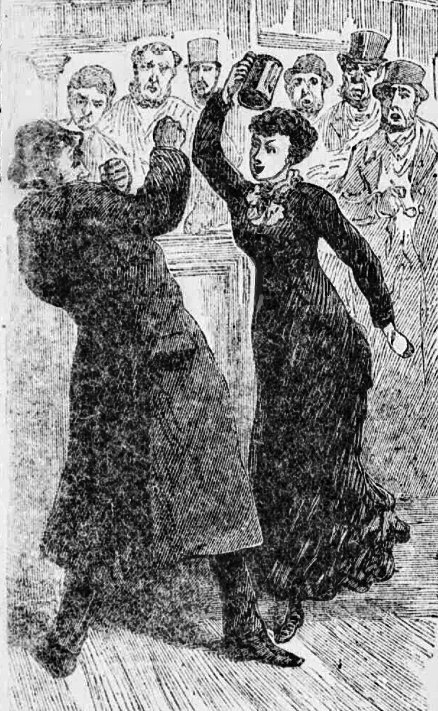
… threatening minister’s wife
annoying the Town Clerk
climbing inside a distillery kiln
(with daughter) attacking neighbour in her own home
throwing boots at a constable’s house
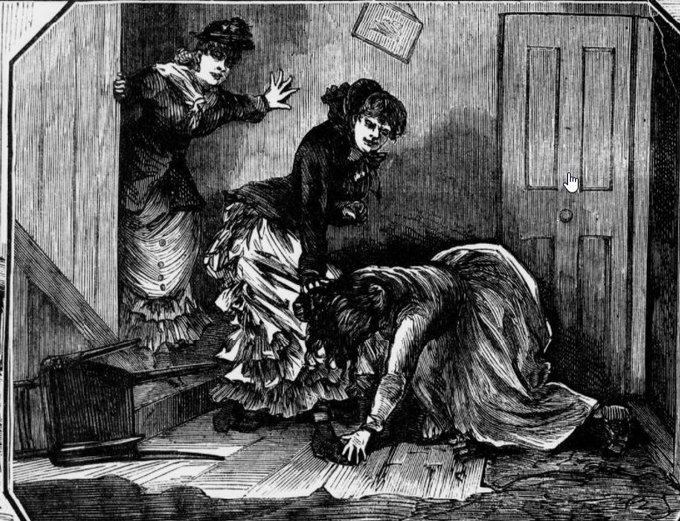
It’s hard to know Nancy’s true total appearances. She had over 200 in Bo’ness Burgh Court (Police Court) and also appeared in Linlithgow Sheriff and Edinburgh City Burgh Courts. Other contenders for the title at the time included Edinburgh’s Flora Smith, who had her 169th appearance in March 1911, and Dundee’s Ann Dolan Hall (who had an unconfirmed 232 appearances in Edinburgh City Court in March 1902).
In 1597, Aberdeenshire woman Ellen Gray was accused of using sorcery, witchcraft, and charms on farm worker Thomas Reddoch “so that his wand nevir lay doune”. Thomas apparently later died from his condition.

In April 1650, Brechin woman Catharin Walker was accused of witchcraft, for, among other things, booting a man in the balls so hard he died.
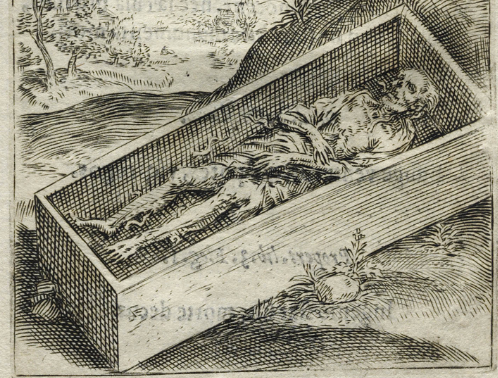
Her accusers also claimed:
She had a meeting with the devil in the form of a cat and made a pact with him
She had kicked another man in the groin (and that he also died)
She had poisoned cattle and children
She had used incantations to summon the devil in her prison cell
She had brought some sort of pestilence upon Brechin.
While we know that the man who died post-booting was named Beattie, the records of the Brechin presbytery don’t say what Catharin’s fate was. No commission to try her has been found in the records, so she may have been acquitted. However, she was found by witchpricker John Kincaid to have had the “Devil’s mark” on her, and she had at some point confessed to murder–not easy things to shake and unlikely to get you let out of jail.*
*thanks to Louise Yeoman and Ciaran Jones for this insight on Catharin’s fate.
Some unusual cases and executions in 16th and 17th century Edinburgh:
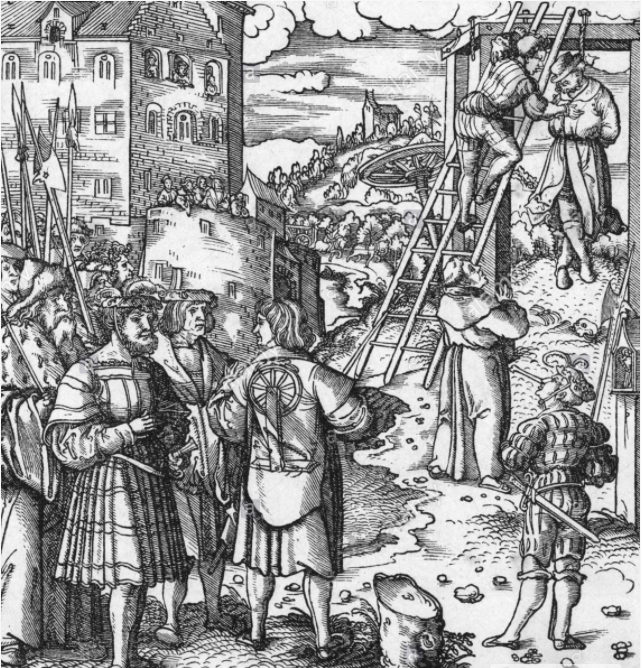
30th Jan 1603: Francis Moubray breaks his neck and dies escaping from Edinburgh castle. Next day was taken to gallows, hanged, quartered, beheaded, and displayed at the four city gates.
2nd July 1602: Alexander Rowan (ane cruel man) hanged for “setting ane woman’s bare arse on ane girdill quhen it wes red hot”
3rd July 1602: Johne Stewart beheaded for “cutting off ane man’s privat members”
1572: Christian Gudson, executed for biting off her husband’s finger
27th April 1601: For hanging a picture of the king and queen from a nail on the gibbet (to keep it off the ground), Archibald Cornwall hanged, gibbetted, and burnt.
13th May 1572: Two men and a woman hanged for bringing leeks and salt into Edinburgh without permission
20th February 1598: Thomas Dobie, for drowning himself in a quarry, he was hurled through town and hanged at the gallows.
16th June 1604: Robert Weir (for murder) was tied to a cartwheel and broken with the coulter of a plough.
In October 1525, Archbishop of Glasgow, Gavin Dunbar wrote an angry hellfire and damnation curse upon the Border Reivers to be read out before mass in the areas the Reivers preyed on. 1478 words long, here are some snippits in modern Scots.

“I CURSE thair heid an aa the hairs o thair heid; I CURSE thair face, thair een, thair mouth, thair nose, thair tongue, thair teeth, thair craig, thair shoulders, thair breist, thair hert, thair stomach, thair back, thair wame, thair arms, thair legs, thair hands, thair feet an ilka pairt o thair body, frae the tap o thair heid tae the sole o thair feet, afore an ahint, within an outwith. I CURSE thaim gangin, an I CURSE thaim ridin; I CURSE thaim staunin, an I CURSE thaim sittin; I CURSE thaim eatin, I CURSE thaim drinkin;”
He goes on:
“I CURSE thaim waukin, I CURSE thaim sleepin; I CURSE thaim risin, I CURSE thaim lyin; I CURSE thaim at hame, I CURSE thaim frae hame; I CURSE thaim in the house, I CURSE thaim out the house…”
He also CURSES: their wives, bairns, servants, crops, cattle, wool, sheep, horses, pigs, geese, hens, livestock, halls, rooms, kitchens, stables, barns, byres, yards, kail, ploughs, harrows…
You can hear the whole (9 minutes) of the curse here: http://reivers.info/the-bishops-curse-dialect/
Borland, R. (1898) Border Raids and Reivers. Thomas Fraser, Dalbeattie. pp. 274-279
In the 1600s, Nairn paid “honest men” called cunnisters to publicly “tak tryall o the ale or beer from every inn thrice weekly” and loudly declare whether it was good or not. Brewers were fined a shilling for every bad pint the cunnisters got.

Update:
Seems that “ale-cunnars” have been important roles in Scottish burghs since at least the 15th century including references from Peebles (1460), Prestwick (1470), Dunfermline (1497), Stirling (1548), and Lanark (1569)
Bain, G. (1893) History of Nairnshire. Nairn Telegraph Office, Nairn. pg.333
“cunnar”. Dictionary of the Older Scottish Tongue. https://dsl.ac.uk/entry/dost/cunnar